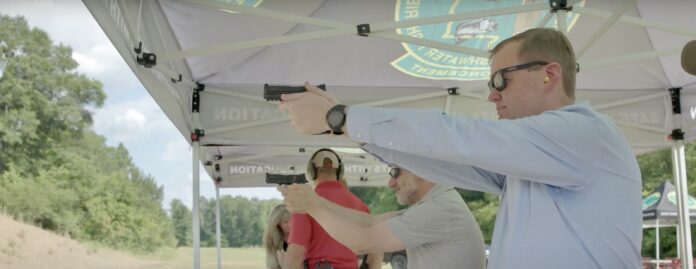How conservation and outdoors recreation are funded throughout the nation is somewhat of a mystery for most people.
In an effort to inform the public about where state wildlife and fisheries agencies get the money to conserve habitat and provide quality outdoors recreation, the Alabama Department of Conservation and Natural Resources’ (ADCNR) Wildlife and Freshwater Fisheries (WFF) Division is teaming with the Outdoor Stewards of Conservation Foundation and the firearms and ammunition industry to promote Connecting with Conservation, a video series that explains the process. The program highlights the shift in user groups as well.
“From the time when the Pittman-Robertson Act was passed in the late 1930s, hunters have paid the lion’s share of wildlife conservation in America,” said Chuck Sykes, WFF Director. “Hunters buying licenses and also buying guns and ammunition, those are basically the funding sources for state agencies. It’s Pittman-Robertson excise tax dollars that the manufacturers pay, and the license dollars that hunters pay.
“That’s how states have bought property for public hunting. That’s how states provide services and do research. That’s the cornerstone of conservation in the United States.”
Sykes said in the past decade, especially the past five or six years, agencies have seen a huge shift in who is actually funding conservation. Hunters are being passed by recreational and target shooters, who are now paying the lion’s share of excise taxes.
“For state agencies to remain relevant and to support people who are actually paying for that conservation now, states have had to change their business models a little bit,” he said. “Instead of everything going for wildlife management like it has been for the past 80 years, now we’re focusing a lot on providing recreational shooting opportunities.”
Alabama has provided shooting opportunities at 12 public shooting ranges throughout the state. A 13th range is now being designed in Shelby County with an emphasis on recreational and target shooting. Visit www.outdooralabama.com/activities/shooting-ranges for information on the ranges.
“Of the 12 shooting ranges, most were built with hunters in mind, and they are on a WMA (wildlife management area),” Sykes said. “They’re 5 miles down a dirt road and hard to get to. People who are non-hunters are not comfortable going there to shoot.
“Now, we are putting our focus on finding properties that have easy access for people who aren’t hunters but still pay into the system to have a safe environment where they can go shoot. So, our purchase in Shelby County is the first of, hopefully, many to come.”
Federal excise taxes are also collected on archery equipment much in the same manner that they are collected on firearms and ammunition. In the spirit of giving back to those who fund conservation, Alabama’s Wildlife and Freshwater Fisheries Division leads the nation in archery parks with 20 currently spread across the state. Go to www.outdooralabama.com/activities/archery-parks for an interactive map and list of activities available at each park.
Sykes said this shift will not change the WFF’s commitment to the people who have funded conservation for generations.
“We’re not turning our back on our traditional users,” he said. “We still have hunters and anglers at the forefront of what we do. But we can’t deny the fact that we need to partner with recreational shooters and provide a place for them to practice and get more proficient with a firearm. I think there were eight million new gun owners a couple of years ago. There are a lot of people buying guns and ammo now that didn’t grow up the way we did. It’s our job as a state agency to provide places where they feel comfortable.
“That’s where this Connecting with Conservation comes in. Most of us are biologists and not communicators. We have not told our story very well. It takes manufacturers making guns and ammo. It’s takes hunters buying licenses, guns and ammo. And it takes state agencies on the ground for all of this to work. It can’t work without all three. Some of the manufacturers don’t know where the excise tax goes. Some hunters, especially the late-onset hunters, and recreational shooters don’t have any idea that what they’re doing is actually paying for conservation. This concept is to get all these different groups on the same page so we can have a collective voice to tell our story.
Sykes said the initiative is a program that will eventually include other states and other industry partners to try to educate the public on conservation efforts throughout the nation. Go to www.youtube.com/watch?v=WyXAIa6oHgQ to watch a video on the program.
“We were fortunately one of the first states to do it,” Sykes said. “We have a good partner with Creedmoor Sports in Alabama, so it just made sense.”
Jim Curcuruto, Executive Director of the Outdoor Stewards of Conservation Foundation, said the Connecting with Conservation program is what he calls a “thank you” party.
“It’s states thanking their people for buying hunting and fishing licenses, the manufacturers thanking the people for buying their products, and the manufacturers thanking the state agencies for doing all the cool work they’re doing with the funding,” Curcuruto said. “We want the end users to find out that ‘Oh, I didn’t know we were primary funders of conservation.’
“Outdoor Stewards of Conservation is a nonprofit with a mission to do research-based marketing to help recruit the next generation of what we call HATS (hunters, anglers, trappers and shooters) and promote the fact that HATS are primary funders of land, fish and wildlife conservation in America.”
Curcuruto said each year about $1.5 billion is raised through excise taxes, and these funds are combined with license revenue to make up the bulk of state fish and wildlife agency budgets. The excise tax funds are distributed to the states according to a formula that includes the number of licenses sold and the state’s land mass.
“When you add in people who buy duck stamps or donate to Ducks Unlimited or the National Wild Turkey Federation, it comes to about $10 million a day,” he said. “Without that money from hunting and fishing licenses and excise taxes, state agencies would be in trouble. Without the DCNRs on the ground, getting their hands dirty, buying new land, managing those lands and the wildlife, conservation in America would fall apart. The important part is creating those messages so people understand this.”
Curcuruto said five additional videos will be produced to convey the messaging, and anyone interested can go to www.outdoorstewards.org for more information about the “Fill a Bag While Filling Your Tag” program to reduce litter.
“I think we’ve overcomplicated the message and it’s confused people,” he said. “Now, we’re just saying thanks for being a primary funder of conservation.”
John Teachey, Vice President of Operations and Marketing with Creedmoor Sports in Anniston, said the company has been rooted in shooting sports for the past 40 years, catering to the participants in the Civilian Marksmanship Program, which has its distribution center in Anniston.
“One of the things that Connecting with Conservation does is make it clear to individuals that state conservation funding, for the most part, comes from the Pittman-Robertson Act,” Teachey said. “The program tries to make it widely known that those of us who manufacture firearms, manufacture ammunition are not only supplying individuals with those goods they need, but we’re also paying for state conservation through excise taxes.
“The program is to increase awareness and show what our industry does. We’re not just here to make product and make money. We’re also giving a lot back through these federal programs for state agencies. We see value in it because it truly shows what our industry does. Right, wrong or indifferent, our industry has been a target of many people for the last decade plus. There are some people who would love to see this industry go away forever. This has been my profession for my entire career, and I want people to understand what our industry does and show the positive things that we do as well.”




